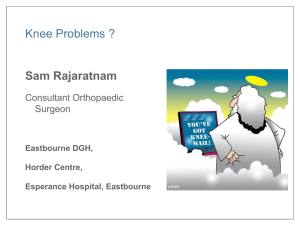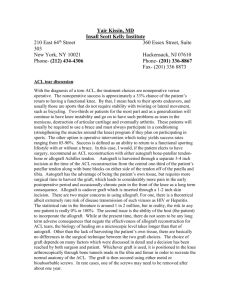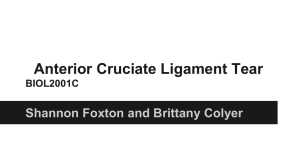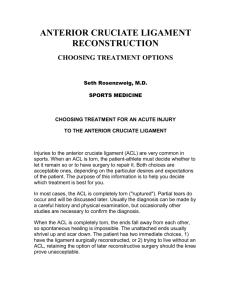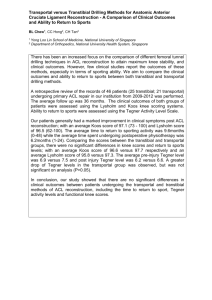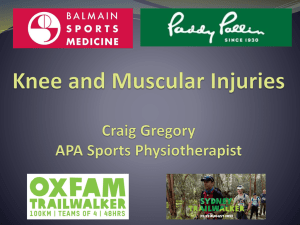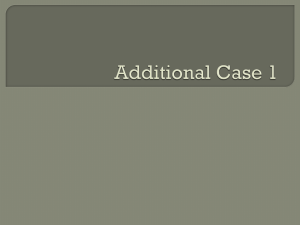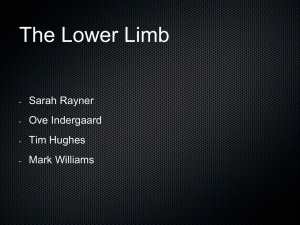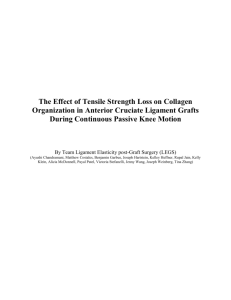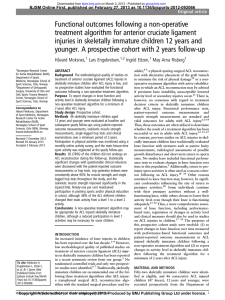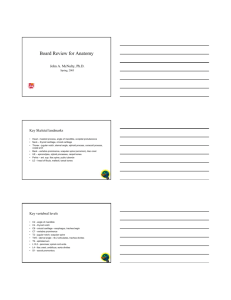Sports-Related-Knee-Injuries
advertisement
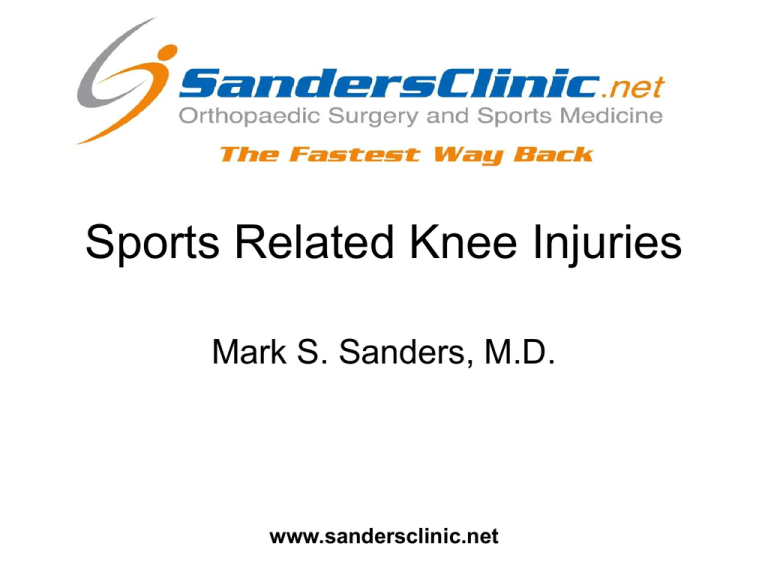
Sports Related Knee Injuries Mark S. Sanders, M.D. www.sandersclinic.net Sports Related Knee Ligament Injuries • • • • • Anatomy of the Knee Mechanisms of Injury Diagnosis Reconstruction Therapy and Rehabilitation Frank H. Netter, Atlas of Human Anatomy 4th Ed. Frank H. Netter, Atlas of Human Anatomy 4th Ed. Frank H. Netter, Atlas of Human Anatomy 4th Ed. Frank H. Netter, Atlas of Human Anatomy 4th Ed. Frank H. Netter, Atlas of Human Anatomy 4th Ed. Frank H. Netter, Atlas of Human Anatomy 4th Ed. Frank H. Netter, Atlas of Human Anatomy 4th Ed. Frank H. Netter, Atlas of Human Anatomy 4th Ed. Anterior Cruciate Ligament • Major stabilizing ligament in the knee connecting the tibia to the femur preventing pathologic anterior excursion of the tibia on the femur • Contains mechanoreceptors which supply the nervous system with real time information regarding the limb’s position in space Mechanisms of Injury • Can be torn by a sudden violent contraction of the quadriceps occurring on the misplanted foot – Most common cause of ACL injuries in noncontact sports • In collision sports it occurs as a result of an externally applied force projected directly on the medial or lateral surface of the knee • Hyperextension When the ACL Tears • A patient reports hearing or feeling a “pop” • There is a sense that the knee “went out” or dislocated • The pain typically makes it impossible to finish the day's activities • May also result in collateral ligament, articular surface, and/or meniscal cartilage damage http://www.youcanbefit.com/images/ACL%20tear%20cause.bmp http://www.hughston.com/hha/b_11_3_2b.jpg http://www.weissortho.com/images/sectionimages/commoninj uries/bodyparts/big/acltear.jpg http://cms.depuy.com/display?docId=20157 Diagnosis • • • • • • • • History Physical Examination Straight leg raising possible large knee effusion loss of active knee motion Lachman’s sign (anterior draw in mild flexion) Pivot shift sign (uncommon in acute situation) Collateral ligament examination in full extension and 30 degrees of flexion • • KT-1000 X-ray • • MRI Arthroscopy http://www.jfponline.com/images/5209/5209JFP_AppliedEvidence-fig2.jpg MEDmetric® Knee Ligament ARTHROMETER® Model KT1000™ MRI • Advantages/Disadvantages? http://www.emedx.com/emedx/diagnosis_information/diagnosis_information_image _files/knee_images/acl_mri_torn.JPG http://www.rad.washington.edu/staticpix/anatomy/ACL1.jpg Arthroscopy • Not typically necessary for diagnosis, which should be obvious from History, Physical Examination, KT-1000 testing, and/OR MRI • Most often MRI is not necessary for diagnosis, but can be helpful in determing the presence of other injuries • bone contusion (bone marrow edema) – articular or meniscal cartlage injury – collateral ligament injury (should be obvious from physical exam) http://www.yoursurgery.com/procedures/arthroscopy/images/ACL_PCL.jpg http://www.genou.com/LCAnormal.jif http://www.emedx.com/emedx/diagnosis_information/diagnos is_information_image_files/knee_images/acl_normal_arthros copic_picture.JPG Initial Treatment • Surgery NOT INDICATED – Immediate surgery leads to an unacceptable incidence of arthrofibrosis (loss of ROM) • RICE – – – – Rest Ice Compression Elevation • Range of Motion exercises • Gait reeducation – quickly eliminates the need for crutches • Cold/compression CryoCuff® • Strengthening and flexibility program for hamstrings and quadriceps • Emphasize extension equal to the other leg • Cycling Options? • Non-surgical – Must be willing to give up sports with exception of cycling and activities in a health club • Strength and conditioning program • Surgical – For people that want to return to sports and need the stability (athletes) Allografts • Advantages – Technically easy • Biological Considerations – Greater than one year for revascularization – Rejection – Infectious transmission • Technically easy • Economic considerations – Very expensive • Success Rate 80% stable knees • Return to sports not before one year • Indications – Non-athletic patients over 40 Hamstring Tendon • Advantages – Technically easy • Disadvantages – Lack of bone to bone healing – Maturation takes one year – Sacrifice of a major muscle group that provides major posterior translation of the tibia (the hamstring tendons are the allies of the ACL) • Success rate 90% stable knees • Return to sports 9 months to one year • Long term hamstring weakness present Bone-Patellar Ligament-Bone • GOLD Standard • Advantages – Bone to bone healing – Strongest graft – Maturation occurs rapidly • Return to sports 6 months • Disadvantage – Requires attention to detail at surgery and rehab Contra lateral patella tendon • (PLATINUM standard) • Less postop pain • Faster rehab – Divide the problem into two parts – ACL leg concentrates on ROM – Graft leg concentrates on Strength • No braces or crutches • Return to sports 3 months – Improvement continues over first year Procedure • A short straight incision is made on the ACL knee superficial to the patella and a small incision is made lateral and superficial to the distal femur • Drill holes are placed into the knee - from the leg and thigh - into the places where the native ACL inserts into the femur and tibia • A similar incision is made onto the front of the healthy “graft” leg • The graft is harvested and the wound is closed over a drain • The new graft is then placed through the ACL knee and sutures are tied over buttons • The wounds are then closed over drains - preventing excessive fluid build up for optimal recovery and movement • Cold compression is applied on both legs and strengthening movements begin that day Full extension equal to the other leg necessary on the operating table and at all other times Therapy and Rehabilitation • • • • • • • Immediate! ROM key on ACL leg! Strengthening key on graft leg Gait training Jogging in 1 month Sports specific drills 6 weeks Criteria for returning to sports – – – – – Full and equal motion in both knees Strength equal to 80% of preop graft leg both knees Swelling absent Plyometrics Neuromuscular reeducation • Average return to sports 3 months – Confidence and performance continue to improve for one year 3 Days Postop Hardin g forwar d and backw ards Angela hall website For More Information • Visit our website at www.sandersclinic.net
